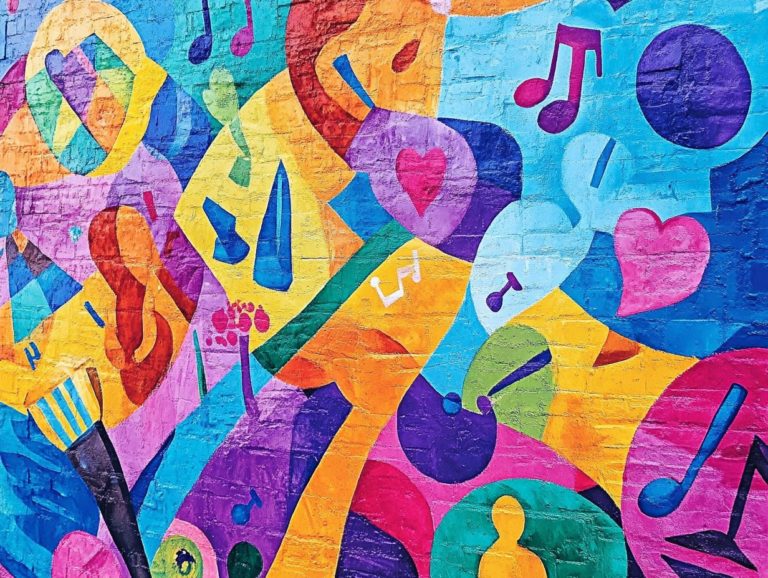5 essential cultural topics for language learners
Understanding culture is essential for anyone learning a new language. It goes beyond grammar and vocabulary; it s about forging meaningful connections with people.
From unique customs to local holidays, every aspect shapes communication.
This article unveils five cultural topics every language learner should grasp. You ll see how cultural awareness enriches your language skills and helps clear common misunderstandings.
Join the journey as you discover the rich tapestry of culture that accompanies your language learning adventure!
Contents
- Key Takeaways:
- 1. Cultural Customs and Etiquette
- 2. Holidays and Celebrations
- 3. Social Norms and Values
- 4. Food and Dining Etiquette
- 5. Nonverbal Communication
- Why Is Understanding Culture Important for Language Learning?
- What Are the Benefits of Learning About Different Cultures?
- Frequently Asked Questions
- What are the 5 essential cultural topics for language learners?
- Why are these cultural topics important for language learners?
- How can language learners learn about these cultural topics?
- What is the significance of greetings and introductions in a language’s culture?
- How can understanding customs and etiquette enhance language learning?
- Why is it important for language learners to learn about food and dining in a language’s culture?
Key Takeaways:

Respect cultural customs and etiquette to avoid misunderstandings and build relationships with native speakers.
Learn about holidays and celebrations to gain deeper insights into a culture’s history, traditions, and values.
Understand social norms to navigate new cultures effectively.
1. Cultural Customs and Etiquette
Cultural customs are key to effective communication. They give you insights into the diverse contexts that shape interactions.
Embracing understanding of different cultures allows you to design a curriculum that nurtures empathy and respect.
For example, in Japan, bowing shows respect. In many Middle Eastern cultures, greetings often include questions about family, highlighting relationship importance.
Understanding these customs enhances your language skills and communication style. It leads to a vibrant learning environment where language and culture unite, fostering deeper connections among diverse students.
2. Holidays and Celebrations
Holidays and celebrations are vibrant expressions of cultural identity. They provide rich opportunities to engage in cultural understanding and appreciate diverse perspectives.
Festivals like Diwali in India, Hanukkah in Jewish communities, and the Lunar New Year illustrate unique customs that reflect historical narratives and social values.
In language education, integrating these celebrations enhances vocabulary and fosters empathy for different ways of life.
Through storytelling, music, and art connected to these holidays, educators create immersive experiences that spark curiosity and enhance cultural understanding.
3. Social Norms and Values
Understanding social norms is essential for effective communication and empathy. These elements shape interactions and influence language learning.
Cultural factors impact how ideas are expressed, feedback is delivered, and conflicts are resolved. Some cultures prioritize direct communication, while others favor indirect approaches that emphasize harmony.
This knowledge helps create inclusive classrooms that acknowledge diverse backgrounds, making it easier for students to share their perspectives.
By integrating culturally responsive teaching, you enhance language proficiency and foster critical thinking that promotes cross-cultural understanding.
4. Food and Dining Etiquette

Food and dining etiquette provide captivating insights into cultural practices and traditions. These customs act as powerful catalysts for cultural exchange, significantly enhancing your language skills and fostering effective communication.
Take Japan, for example. The customs surrounding sushi consumption emphasize respect for food and proper chopstick usage.
Then there s Mexico, where communal meals beautifully underscore the value of sharing and family connections.
By weaving these diverse practices into the language curriculum, educators like you can craft engaging lessons. These lessons not only teach food-related vocabulary but also immerse students in the rich social contexts surrounding these culinary traditions.
This method encourages appreciation for manners, regional cuisines, and meal preparations from around the globe. It cultivates an environment of curiosity and mutual respect among classmates.
5. Nonverbal Communication
Nonverbal communication is an important part of conveying meaning across diverse cultural contexts. It emphasizes the necessity of understanding different cultures to foster effective communication within language education.
The nuances of body language, facial expressions, and gestures vary significantly from one culture to another. As an educator, you must be attuned to these differences.
For example, while a thumbs-up gesture is often seen as a sign of approval in many Western cultures, it can be considered offensive in certain parts of the Middle East. Similarly, maintaining eye contact conveys confidence in some societies, yet it may be viewed as disrespectful in others.
Recognizing these nonverbal cues helps create a more inclusive classroom environment. This ultimately enhances student learning and ensures that all learners feel understood and respected.
Why Is Understanding Culture Important for Language Learning?
Understanding culture is essential for your language learning journey. It elevates the educational experience and gives you the power to acquire language skills more effectively.
Engaging with the community becomes more meaningful when you possess enhanced cultural awareness and effective communication abilities. Cultural insights help you develop your language skills by providing the contextual knowledge needed for authentic interactions.
By immersing yourself in the values, beliefs, and traditions associated with a language, you won t just learn vocabulary and grammar; you ll also grasp the nuances that make communication effective.
This deeper cultural understanding cultivates empathy, allowing you to appreciate diverse perspectives and experiences. Embracing inclusive pedagogy that integrates cultural context fosters an environment where you and your peers feel valued and understood.
What Are the Benefits of Learning About Different Cultures?
Exploring different cultures offers a wealth of benefits, such as developing cultural competence and enhancing empathy. This journey enriches your lifelong learning and cross-cultural understanding.
With this knowledge, you cultivate improved communication skills, enabling you to articulate your thoughts more effectively. It also enhances your adaptability, equipping you to navigate multicultural environments with confidence.
As you engage with diverse backgrounds, you become more aware of your own biases. You learn to value differing viewpoints, elevating classroom discussions to new heights.
These enriching experiences lead to more dynamic educational strategies and ignite creativity. They inspire collaboration and prepare you for a globalized world.
How Can Cultural Awareness Improve Language Learning?

Cultural awareness significantly enhances your language learning journey. It offers essential insights that deepen your understanding of language use and empower you to communicate effectively in diverse contexts.
By integrating authentic materials like local literature, music, and art into your lessons, you open up rich opportunities to explore various cultures. This allows you to cultivate a deeper appreciation for diverse perspectives.
Utilizing cultural referents in discussions from common phrases to traditional customs enables you to grasp the real-world applications of what you study. This approach boosts your engagement and fosters empathy as you begin to recognize and respect differing viewpoints and experiences.
When language educators adopt these strategies, they create a more inclusive environment that encourages active participation. This transforms learning into a collaborative and enriching experience.
What Are Some Common Cultural Misunderstandings for Language Learners?
Cultural misunderstandings often arise for language learners, stemming from varying perceptions of social norms and values. This highlights the pressing need for effective communication and cultural awareness in the language education process.
For instance, you might encounter a student from a collectivist culture who struggles to understand the individualistic discussions typical in Western classrooms, where sharing personal opinions is encouraged and expected.
Similarly, idioms and phrases unique to a language can lead to confusion. Imagine a learner saying they’re ‘on cloud nine’ without realizing it simply means they’re happy, not literally floating in the sky.
To tackle these challenges, educators can embrace teaching that respects different cultures. This means integrating multicultural content into the syllabus, encouraging students to share their backgrounds, and creating a welcoming atmosphere where questions about cultural differences are actively explored.
How Can One Learn About a Culture While Learning a Language?
Learning about a culture while mastering a language is best achieved through immersive experiences, cultural exchange programs, and building community relationships. These deepen your contextual understanding and enhance your language proficiency.
These approaches create a vibrant tapestry of learning opportunities. They encourage you to engage with native speakers in authentic settings.
For instance, when you participate in local festivals or food fairs, you immerse yourself in traditional customs and culinary delights. This also gives you a chance to practice your conversational skills in a lively atmosphere.
Connecting with host families can foster meaningful relationships. This provides insights into daily life and social norms that textbooks often overlook.
All of these experiences come together to offer you a more comprehensive language education, seamlessly weaving linguistic skills with cultural appreciation.
What Are Some Resources for Learning About Different Cultures?
You can explore many exciting resources for discovering different cultures. These range from insightful books and captivating documentaries to dynamic online platforms. These tools significantly enhance educational environments and offer invaluable cultural insights for language learners.
By leveraging platforms like YouTube for engaging documentaries, Google Arts & Culture for virtual museum tours, and language-learning apps such as Duolingo that seamlessly weave in cultural context, you can elevate your curriculum. These resources present diverse perspectives and invite you to engage actively with material that resonates with your interests.
Incorporating literature and music from various cultures fosters a more inclusive atmosphere. This allows students to explore identities and histories that extend beyond their own. Collectively, these resources nurture a deeper understanding and appreciation of multiculturalism within the classroom.
Frequently Asked Questions

What are the 5 essential cultural topics for language learners?
Language learners should focus on five key cultural topics, including greetings and introductions, customs and etiquette, food and dining, holidays and celebrations, and social norms and values.
Why are these cultural topics important for language learners?
These topics help learners communicate effectively with native speakers and also deepen their understanding of the language and its cultural context.
How can language learners learn about these cultural topics?
Language learners can explore cultural topics through immersion programs and language classes, as well as must-visit cultural institutions. Online resources and conversations with native speakers are also valuable.
What is the significance of greetings and introductions in a language’s culture?
Greetings and introductions reflect a culture’s values and customs. They set the tone for communication and show respect for others.
How can understanding customs and etiquette enhance language learning?
Knowing customs and etiquette helps learners navigate social situations smoothly. It builds stronger relationships with native speakers and enriches cultural understanding.
Why is it important for language learners to learn about food and dining in a language’s culture?
Food is central to any culture. Learning about it provides insight into traditions and beliefs, allowing learners to appreciate the diversity of food cultures authentically.





